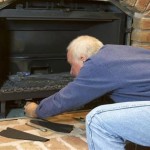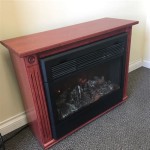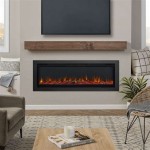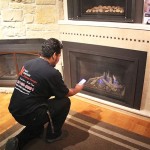How to Tile Around a Fireplace Insert: A Comprehensive Guide
Tiling around a fireplace insert is a popular way to enhance the aesthetic appeal of a living space while also providing a durable and heat-resistant surface. This process, while achievable for many homeowners, requires careful planning, precise execution, and a thorough understanding of the materials and techniques involved. A well-tiled fireplace surround can transform a room, creating a focal point that is both beautiful and functional. This article provides a comprehensive guide to tiling around a fireplace insert, covering everything from preparation to installation.
Before embarking on this project, it is crucial to verify local building codes and regulations pertaining to fireplace surrounds and the use of specific tiling materials near a heat source. These codes often dictate minimum clearances, acceptable materials, and required installation methods to ensure safety and prevent fire hazards. Ignoring these regulations can result in costly rework and potential safety risks.
Assessing the Existing Structure and Planning the Layout
The initial step involves a thorough assessment of the existing substrate surrounding the fireplace insert. This substrate is the surface onto which the tiles will be adhered, and its condition is paramount to the success of the project. Common substrate materials include drywall, cement board, and brick. Drywall, unless specifically rated for high temperatures, is generally not suitable for tiling directly around a fireplace insert. Cement board, also known as backer board, is a more appropriate choice due to its heat resistance and moisture resistance. Brick, if structurally sound and properly prepared, can also serve as a suitable substrate.
Inspect the substrate for any signs of damage, such as cracks, crumbling, or water damage. Repair any existing damage before proceeding. Loose or uneven surfaces should be leveled and reinforced as necessary. The substrate must be clean, dry, and free of any debris, dust, or grease. This can be achieved by thoroughly cleaning the area with a suitable cleaning solution and allowing it to dry completely.
Once the substrate is prepared, the next step is to plan the tile layout. This involves determining the tile arrangement, spacing, and overall design. Consider the size and shape of the fireplace insert, the dimensions of the surrounding wall, and the desired aesthetic. It is often helpful to create a scaled drawing or use a tile layout software to visualize different design options.
When planning the layout, pay attention to the placement of full tiles and cut tiles. Aim for a symmetrical and balanced design, with full tiles prominently featured and cut tiles strategically placed in less conspicuous areas. Consider starting the layout from the center of the fireplace insert and working outwards, ensuring that the tile pattern is centered and visually appealing. Use tile spacers to maintain consistent grout lines and ensure proper alignment. The size of the grout lines can affect the overall look of the tiled surface; wider grout lines can create a more rustic or traditional appearance, while narrower grout lines can provide a more modern and seamless look.
Selecting the Right Materials and Tools
Choosing the appropriate materials is essential for a successful and long-lasting tile installation around a fireplace insert. Select tiles that are heat resistant, durable, and aesthetically pleasing. Common tile choices include ceramic, porcelain, stone, and glass. Porcelain tiles are often preferred for their durability, heat resistance, and low water absorption. Stone tiles, such as granite or slate, can add a natural and elegant touch. Glass tiles, while visually appealing, may require special installation techniques and are not always suitable for high-heat areas.
In addition to the tiles themselves, other essential materials include thin-set mortar, grout, sealant, and tile spacers. Thin-set mortar is used to adhere the tiles to the substrate. Choose a thin-set mortar that is specifically designed for the type of tile being used and the type of substrate. Some thin-set mortars are formulated for enhanced heat resistance, which is particularly important for fireplace surrounds. Grout is used to fill the spaces between the tiles, providing a waterproof and aesthetically pleasing finish. Select a grout that is resistant to staining and cracking. Sealant is applied to the grout lines to protect them from moisture and staining. Use a high-quality sealant that is specifically designed for tile and grout.
The tools required for tiling around a fireplace insert include a tile saw, a notched trowel, a rubber grout float, a sponge, a level, a measuring tape, a pencil, and safety glasses. A tile saw is used to cut the tiles to the desired size and shape. A notched trowel is used to apply the thin-set mortar to the substrate. The size of the notches on the trowel should be appropriate for the size and type of tile being used. A rubber grout float is used to apply the grout to the grout lines. A sponge is used to clean the excess grout from the tile surfaces. A level is used to ensure that the tiles are installed level and plumb. A measuring tape and pencil are used to measure and mark the tile layout.
The Step-by-Step Tiling Process
With the materials and tools prepared, the tiling process can begin. Start by mixing the thin-set mortar according to the manufacturer's instructions. The consistency of the mortar should be similar to that of peanut butter. Avoid mixing too much mortar at once, as it will harden before it can be used. Apply the thin-set mortar to the substrate using the notched trowel, holding the trowel at a 45-degree angle to create ridges in the mortar. The ridges will help to ensure proper adhesion of the tiles.
Place the tiles onto the mortar, pressing them firmly into place. Use tile spacers to maintain consistent grout lines. Check the alignment of the tiles with a level and make any necessary adjustments. Work in small sections, applying mortar and setting tiles one section at a time. This will prevent the mortar from drying out before the tiles can be set.
When cutting tiles to fit around the fireplace insert or along edges, use the tile saw. Measure and mark the cut lines precisely. Wear safety glasses to protect your eyes from flying debris. Cut the tiles slowly and carefully, following the marked lines. Smooth the edges of the cut tiles with a rubbing stone or sandpaper to remove any sharp edges.
After all of the tiles have been set, allow the thin-set mortar to cure for at least 24 hours, or according to the manufacturer's instructions. Once the mortar has cured, remove the tile spacers. Prepare the grout according to the manufacturer's instructions. Apply the grout to the grout lines using the rubber grout float, working diagonally across the tiles. Press the grout firmly into the grout lines, ensuring that they are completely filled. Remove the excess grout from the tile surfaces with a damp sponge. Rinse the sponge frequently to avoid smearing the grout.
After the grout has dried slightly, polish the tile surfaces with a clean, dry cloth to remove any remaining grout haze. Allow the grout to cure for at least 72 hours, or according to the manufacturer's instructions. Finally, apply sealant to the grout lines to protect them from moisture and staining. Follow the manufacturer's instructions for applying the sealant. Apply a thin, even coat of sealant and allow it to dry completely before using the fireplace insert.
Throughout the entire process, maintaining cleanliness is crucial. Regularly wipe down the tiles and work area to prevent mortar and grout from hardening on surfaces. This will save time and effort in the long run and ensure a professional-looking finish. Proper ventilation is also important, especially when working with thin-set mortar and grout, which can release fumes. Open windows and doors to provide adequate airflow.
By following these detailed steps and guidelines, homeowners can successfully tile around a fireplace insert, creating a beautiful and functional focal point in their living space. Remember to prioritize safety, adhere to local building codes, and take the time to plan and execute the project meticulously for optimal results.

How To Tile A Fireplace My Uncommon Slice Of Suburbia

How To Tile Over A Brick Fireplace The Handyman S Daughter

How To Tile A Fireplace House One

Mosaic Tile Fireplace Surround Art Renovation

Tiled Fireplace Ideas To Cozy Up Your Space Arizona Tile

110 Diy Fireplace Makeover How To Paint Tile Jessica Welling Interiors

Can I Put Tile On The Fireplace Daltile

Diy Tile Fireplace Makeover The Home Depot

How To Prep A Fireplace For New Tile House One

How To Install A Gas Fireplace With Tile Surround And Wood Mantel Sima Spaces
Related Posts








